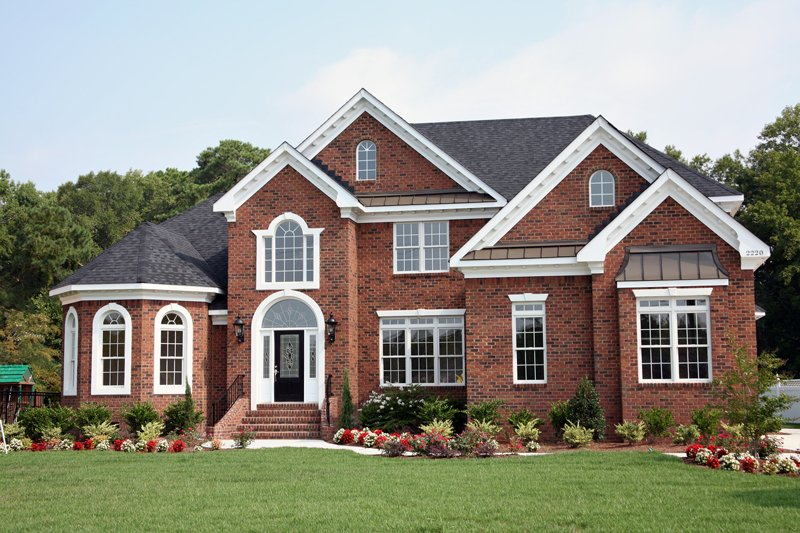Have you ever considered painting your brick? This option is surprisingly versatile and provides you with an array of benefits and style options. Beyond that, painting is also remarkably inexpensive and easy to perform, providing your home with the protection it needs. When you paint brick there are things to consider even with the relative ease of applying exterior paint to your brick house, brick wall or even brick fireplace (or any brick surface).
Pros and Cons of Painting Brick
If you’re sick of your brick – or if the surface of your home is starting to degrade – a new paint job can be a significant step and improve curb appeal. Exterior painting can bring new life to your home, with new paint colors and a fresh coat of paint can provide your home with a variety of benefits that helps to enhance its style and create a better-looking house. Just a few of these benefits include:
- Quick and easy application – Masonry paint provides a straightforward style change that doesn’t require tweaking your home in any other way. When you paint a brick surface the results can be fantastic.
- Affordable upgrade – Unlike other types of style upgrades, which include repairing bricks on your home, painting is relatively inexpensive and finding the right paint can be doable.
- Variety of options – Paints come in many different colors and can create an inspiring array of looks for your home’s exterior. Many popular brands have the right paint available, such as Sherwin Williams, Behr, Romabio and more.
- DIY capabilities – While a competent professional can streamline the painting process for your home, you can do some painting on your own to save a little money. Tools such as a paintbrush, painter’s tape, pressure washer, acrylic latex and more will be needed.
These benefits do outweigh the few negatives that you get when painting brick. For example, painted brick typically shows off mold and mildew more readily than non-painted walls. And you’ll need to repaint your walls every three to five years to keep them looking great.
However, these minor issues don’t make painting a bad option for your brick, particularly if you choose an attractive color for your home. White, black, gray, orange, yellow, and much more all go well on brick and create a unique style upgrade.
Brick Painting Process
Homeowners who want to paint the brick walls need to prepare for this relatively simple process. While painting brick isn’t a complicated ordeal, the techniques utilized may be time-consuming and require a lot of focus and attention. The following steps are the most common in this process:
- Prepare the brick – Your brick must be cleaned with soapy water or a cleaner such as trisodium phosphate to break apart dirt, stains, efflorescence, mold, and mildew. Bleach and a wire brush or scrub brush can help clean the nooks and crannies of a brick house. Some DIY homeowners may use a pressure washer to perform a power washing of the exterior brick walls as part of their prep work. Wait for 24 hours after you wash before you paint. If there are cracks or breaks an acrylic caulk can be applied and allowed to cure.
- Prime the brick – Professionals apply a primer on the brick surface using a paint sprayer or roller, making sure to let the primer thoroughly dry before they start to paint. This wait should take no more than an hour or two. Priming can be a key part, and is sometimes considered part of the prepping for any unpainted surface, but especially for painting brick.
- Paint the brick – Painters also see paints such as elastodynamic varieties to coat the brick walls. A paint sprayer is the most natural choice, here, as it will apply paint quickly and efficiently. Covering all the nooks and crannies will help improve durability of the paint, which covering the entire surface area with a second coat of the right type of paint can make all the difference.
- Let the paint dry on the brick – The next step is to wait an hour or two for the paint to dry and apply at least one more coat. Professionals will add several layers or until you are satisfied.
After the painting is done, consider staining the brick using a high-quality stain. If you choose this option, your painter will wait until the paint is thoroughly dry and then clean the brick surface to avoid issues. Then they’ll use a few coats of stain to protect the surface from weathering damage, such as rain, snow, wind, and other common problems that can quickly degrade your paint job.
Get Professional Help for Painting Your Brick Exterior
So if you want to get your brick home painted in an attractive and appealing color, don’t hesitate to contact us at Elite Painting right away to get the help that you need for your home improvement project. Our experts will inspect your home, choose a color that works for you, and pick a paint style and texture that are attractive for your home’s needs.


